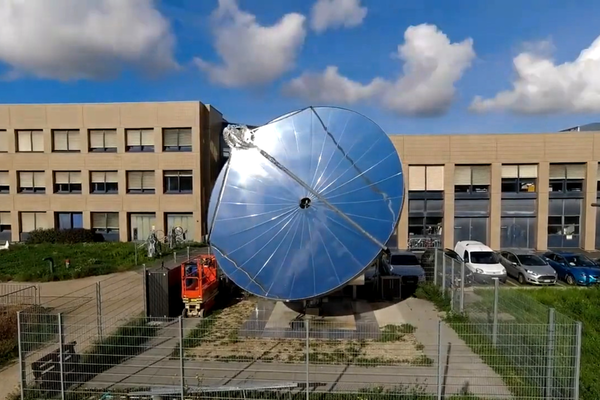A solar hydrogen system that simultaneously generates heat and oxygen is a cutting-edge technology that can be used to generate renewable energy from sunlight. Solar energy is used to split water molecules into hydrogen and oxygen, which can then be used as a clean and sustainable fuel source. Water electrolysis is the process of separating the components of water by passing an electrical current through it.
Researchers created a pilot-scale solar reactor that generates usable heat and oxygen as well as hydrogen with unprecedented efficiency for its size. A parabolic dish on the EPFL campus, which resembles a satellite dish or other telecommunications infrastructure, is easily overlooked. But this dish is unique in that it functions as an artificial tree. After nearly 1,000 times concentrating solar radiation, a reactor above the dish uses that sunlight to convert water into valuable and renewable hydrogen, oxygen, and heat.
“This is the first system-level demonstration of solar hydrogen generation. Unlike typical lab-scale demonstrations, it includes all auxiliary devices and components, so it gives us a better idea of the energy efficiency you can expect once you consider the complete system, and not just the device itself,” says Sophia Haussener, head of the Laboratory of Renewable Energy Science and Engineering (LRESE) in the School of Engineering.
“With an output power of more than 2 kilowatts, we’ve broken through the 1-kilowatt ceiling for our pilot reactor while maintaining record-high efficiency for a reactor of this size.” The hydrogen production rate achieved in this work is a very encouraging step toward commercializing this technology.”
The study builds on preliminary research that demonstrated the concept on a laboratory scale using LRESE’s high-flux solar simulator and was published in Nature Energy in 2019. In the same journal, the team has now published the results of their scaled-up, efficient, multi-product process under real-world conditions.
This is the first system-level demonstration of solar hydrogen generation. Unlike typical lab-scale demonstrations, it includes all auxiliary devices and components, so it gives us a better idea of the energy efficiency you can expect once you consider the complete system, and not just the device itself.
Sophia Haussener
Waste not, want not
Hydrogen production from water using solar energy is referred to as artificial photosynthesis, but the LRESE system is unique for its ability to also produce heat and oxygen at scale.
Following the concentration of the sun’s rays by the dish, water is pumped into its focus spot, which houses an integrated photoelectrochemical reactor. Photoelectrochemical cells in this reactor use solar energy to electrolyze, or split, water molecules into hydrogen and oxygen. Heat is also generated, but instead of being released as a system loss, it is passed through a heat exchanger and harnessed, for example, for ambient heating.
The oxygen molecules released by the photo-electrolysis reaction are recovered and used in addition to the system’s primary outputs of hydrogen and heat. “Oxygen is often perceived as a waste product, but in this case, it can also be harnessed — for example, for medical applications,” says Haussener.

Industrial and residential energy
The system is suitable for industrial, commercial, and residential applications, and it is already being deployed and commercialized by LRESE spinoff SoHHytec SA. The EPFL startup is collaborating with a Swiss-based metal production facility to build a multi-100-kilowatt demonstration plant that will generate hydrogen for metal annealing processes, oxygen for nearby hospitals, and heat for the factory’s hot-water needs.
“With the EPFL pilot demonstration, we achieved a significant milestone by demonstrating unprecedented efficiency at high output power densities.” SoHHytec co-founder and CEO Saurabh Tembhurne says, “We are now scaling up a system in an artificial garden-like setup, where each of these ‘artificial trees’ is deployed in a modular fashion.”
The system could be used to provide central heating and hot water to homes and businesses, as well as to power hydrogen fuel cells. The EPFL campus system could power around 1.5 hydrogen fuel cell vehicles driving an average annual distance, or meet up to half the electricity demand and more than half the annual heat demand of a typical four-person Swiss household at an output level of about half a kilogram of solar hydrogen per day.
Haussener is already exploring new technological avenues as their artificial photosynthesis system nears completion. In particular, the lab is working on a large-scale solar-powered system that would split carbon dioxide instead of water, producing useful materials such as syngas for liquid fuel or ethylene, a green plastic precursor.
















